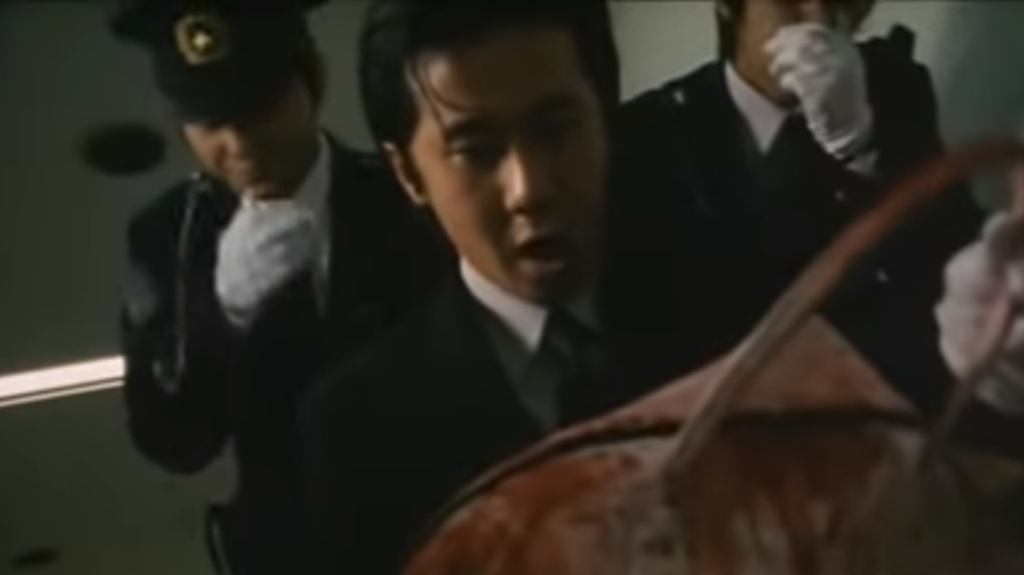Suicide Club
2001

Rated: R
Genre: Crime, Horror
Country: Japan
Run-Time: 1h 39min
Director: Sion Sono
Cast
Ryo Ishibashi……………….Detective Toshiharu Kuroda
Masatoshi Nagase…….Detective Shibusawa
Yoko Kamon…………………The Bat
At a time when Hollywood was greenlighting remakes of everything J-horror, poor Sion Sono seemed like the only director to be left out of loop. I mean, come on! Even Takashi Miike (One Missed Call) and Kiyoshi Kurosawa (Pulse) got ill-advised American remakes.
But for Sono, it wasn’t all bad. At least he didn’t have to watch someone turn one of his films into a travesty. And internationally, there were a number of adventurous filmgoers- the kind that are not put off by subtitles- that wanted to see authentic J-horror titles from its source. And sooner or later a lot of them, including myself, would stumble upon Suicide Club.
For those who don’t know, Sion Sono is a notorious Japanese cult-film director (Cold Fish, Why Don’t You Play in Hell?) who has made a career creating strange, often controversial films that willingly take on subjects considered taboo. Suicide Club (aka Suicide Circle) is no exception. The film exploits the idea of youth suicide, making the ultimate act of finality seem casual. It is the kind of film that all those American studios hoping to make a quick J-horror buck gave a hard pass knowing its subject wasn’t going to come without problems.
Now, I warn those who believe all J-horror involves long haired vengeful girls that this film is not typical of that categorization. Yes, Sono is Japanese, and yes, Suicide Club is horror, but Sono’s filmography, like Takashi Miike, is usually better looked at as its own thing. There is a uniqueness to this film’s style and the storytelling is not characteristic of what most audiences think is Japanese horror.
The films starts off in a subway station. Full stop. I am going to end my summary on that sentence because Suicide Club‘s first scene is also the one most talked about.
Watching Suicide Club can at first be a bit of a challenge because the film lacks an obvious central character. (Detective Toshiharu Kuroda, played by Ryo Ishibashi, is the closest this film gets to one.) The film mostly grounds itself in the investigations of the police, aided by an anonymous hacker named The Bat. At the start of the film, the police are hesitant on whether they can (or even should) open an investigation into a strange series of mass suicides that are occurring around Tokyo. But when white sports bags pop up containing coils of human flesh, it starts to appear that there could be a cult behind the deaths. And if there is a cult, there potentially could be a culprit.
Although Suicide Club takes the subject of suicide relatively lightly, the film is heavily steeped in social commentary. Sono uses his film to critique popular culture and the insidious nature of some trends. When it was made in 2001, Sono was reacting to the uptick in suicides amongst Japanese youth. However, the film’s message still holds relevance today for a TikTok generation that often promotes dangerous stunts and challenges as a quick way for instant fame. The film’s implications are chilling, suggesting that the initial series of mass suicides have made killing oneself trendy. Thus, even if the police can shut down an instigating source, it is possible the suicides might not end. Making matters worse, the film’s various subplots show others who hope to capitalize or take false credit for the wave of deaths.
Meanwhile, the song “Mail Me” by fictional tween J-Pop sensation Dessert is interspersed throughout scenes to imply a possible connection to this horrifying movement. The adults need to pay better attention.
Sono takes advantage of Suicide Club’s episodic format to show us some truly inspired gore, but often at the expense of a cohesive, coherent plot. If Sono has a vice, it is that his films are often too forgiving in the editing room. There is no doubt that some of Suicide Club’s sequences would had been better left on the cutting room floor. But there is also a lot of strangely fascinating originality to the overindulgence on display. (I am talking about you Genesis!) Sono’s tangents, no matter how bizarre, are also what helps to keep Suicide Club a unique and entertaining experience.
Answers to Suicide Club’s mysteries often lay in its insinuations. A good portion of the film’s exposition is about how the suicides are seen as connecting people with something larger than themselves. Growing up as a teenager in the 90s, I’ve seen how this type of destructive thinking can resonate. I have lived in a community that experienced a rash of suicides in the months after Kurt Cobain’s death. (One was a classmate. I hate Cobain.) But there are suggestions, contrary to what the voice on the phone (clear throat) might say, that the suicides are also a result of people becoming disconnected to their families. This latter idea would be explored in more depth by Sono in Suicide Club’s pseudo-sequel Noriko’s Dinner Table, a film that references many of this film’s events. I might had even included Noriko’s Dinner Table in The Midnight Selections if its first two hours were not so heavy on exposition. But to its credit, Noriko’s Dinner Party also culminates towards a final thirty minutes that is mind blowing. If you like Suicide Club you should check it out. The strength of its ending alone is enough for many to consider Noriko the better of the two films. Just don’t go into it expecting to find answers to Suicide Club.
At its best, Suicide Club taps into our worst fears regarding how hopeless we truly are when it comes to preventing the destructive actions of others. This is a film where those in older generations are powerless to prevent the actions of youth and their failures increasingly wear on them. Sono also hammers home the point that when suicide becomes a part of the national conversation, the most likely outcome is to prepare for is more suicide. Suicide Club may close on note of J-Pop innocence, but its lingering questions and horrific imagery will stay with you long after any earworms coming from Dessert’s candy-coated farewell.
